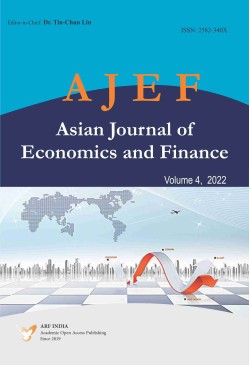MAKE MOST OF THE KNOWLEDGE NETWORK, JOIN ACADEMIC RESEARCH FOUNDATION
Table of Content :-Asian Journal of Economics and Finance, Vol:5, Issue:2, Year:2023
Return on Investment: A Comparison Between Venture Capital Investment Funds and the Venture Builder Approach
BY : Giovanna Colin Zeny, Fernanda Salvador Alves and Ana Paula Mussi Cherobim
Asian Journal of Economics and Finance, Year: 2023, Vol.5 (2), PP.105-118
Received: 28 January 2023 | Revised: 02 February 2023 | Accepted : 10 February 2023 | Publication: 07 June 2023
Doi No.: DOI:10.47509/AJEF.2023.v05i02.01
Keywords: Innovation, Venture Capital Fund, Venture Builder, Return on Investment.
Measuring Impact of CAMELS Model on Financial Performance of Indian Commercial Banks
BY : Tarsem Lal and Arjun Gupta
Asian Journal of Economics and Finance, Year: 2023, Vol.5 (2), PP.119-139
Received: 30 January 2023 | Revised: 12 February 2023 | Accepted : 20 February 2023 | Publication: 07 June 2023
Doi No.: DOI:10.47509/AJEF.2023.v05i02.02
Keywords: Random effect, ROA, ROE, liquidity, sensitivity to market risk, CAMELS.
Economic Growth and Public Expenditure on Human Capital Formation in India: An Econometric Investigation
BY : Jitendra Kumar Sinha
Asian Journal of Economics and Finance, Year: 2023, Vol.5 (2), PP.141-158
Received: 15 March 2023 | Revised: 19 April 2023 | Accepted : 28 April 2023 | Publication: 07 June 2023
Doi No.: DOI:10.47509/AJEF.2023.v05i02.03
Keywords: Human capital; economic growth; education; health.
JEL Classification: C33; F63; H51; H52;I15;I25
Financial Inclusion and Economic Growth in Nigeria (1991-2021)
BY : Linus Egwu Ele and Orji Joseph Ogbonna
Asian Journal of Economics and Finance, Year: 2023, Vol.5 (2), PP.159-174
Received: 25 March 2023 | Revised: 21 April 2023 | Accepted : 04 May 2023 | Publication: 07 June 2023
Doi No.: DOI:10.47509/AJEF.2023.v05i02.04
Decoding the Indian Economic Slowdown: An Insight into the Factors behind the Stumble
BY : Baranidharan Subburayan
Asian Journal of Economics and Finance, Year: 2023, Vol.5 (2), PP.175-208
Received: 22 April 2023 | Revised: 06 May 2023 | Accepted : 14 May 2023 | Publication: 07 June 2023
Doi No.: DOI:10.47509/AJEF.2023.v05i02.05
Keywords: Indian Economy, Economic Challenges, Management Strategies, Crisis and Recession, COVID-19 Pandemic, Economic Growth, Consumer Spending, Investment, Exports, Policymakers.
Causality between Carbon Dioxide Emission and Agriculture Production: Evidences from India
BY : Swami Prasad Saxena and Anuj Kumar
Asian Journal of Economics and Finance, Year: 2023, Vol.5 (2), PP.209-217
Received: 07 May 2023 | Revised: 27 May 2023 | Accepted : 01 June 2023 | Publication: 07 June 2023
Doi No.: DOI:10.47509/AJEF.2023.v05i02.06
Keywords: Carbon dioxide Emission, Agriculture Productivity, Energy Consumption, Granger Causality test
The Repercussions of Ukraine’s Crisis on Food Security and the Possibility of Avoiding a Global Food Crisis
BY : Youssef M. Hamada
Asian Journal of Economics and Finance, Year: 2023, Vol.5 (2), PP.219-229
Received: 27 April 2023 | Revised: 19 May 2023 | Accepted : 30 May 2023 | Publication: 07 June 2023
Doi No.: DOI:10.47509/AJEF.2023.v05i02.07
Keywords: Strengthen food security (SFS) as a mathematical model consists of two models: the first maximizes nutritional value, and the second minimizes production costs to strengthen food security (SFS).
Determinants of Earnings Quality of Listed Consumer Goods Firms in Nigeria
BY : Etim Osim Etim, Nsima Johnson Umoffong, Augustine Brendan Inyang and Nsikan Umanah
Asian Journal of Economics and Finance, Year: 2023, Vol.5 (2), PP.231-248
Received: 01 May 2023 | Revised: 27 May 2023 | Accepted : 02 June 2023 | Publication: 07 June 2023
Doi No.: DOI:10.47509/AJEF.2023.v05i02.08
Keyword: Earnings Quality, managerial ownership, firm size, liquidity
A Discourse on Role of Digital Payments Adoption to Drive MSMEs Towards the Attainment of Sustainable Advantage
BY : Harleen Kaur and Priya Devi
Asian Journal of Economics and Finance, Year: 2023, Vol.5 (2), PP.249-265
Received: 05 May 2023 | Revised: 30 May 2023 | Accepted : 03 June 2023 | Publication: 07 June 2023
Doi No.: https://DOI:10.47509/AJEF.2023.v05i02.09
Keywords: Digital Payments, Sustainable Development Goals, MSMEs, Innovation
Harleen Kaur & Priya Devi (2023). A Discourse on Role of Digital Payments Adoption to Drive MSMEs towards the Attainment of Sustainable Advantage. Asian Journal of Economics and Finance. 5(2), 249-265. https://DOI:10.47509/AJEF.2023.v05i02.09
